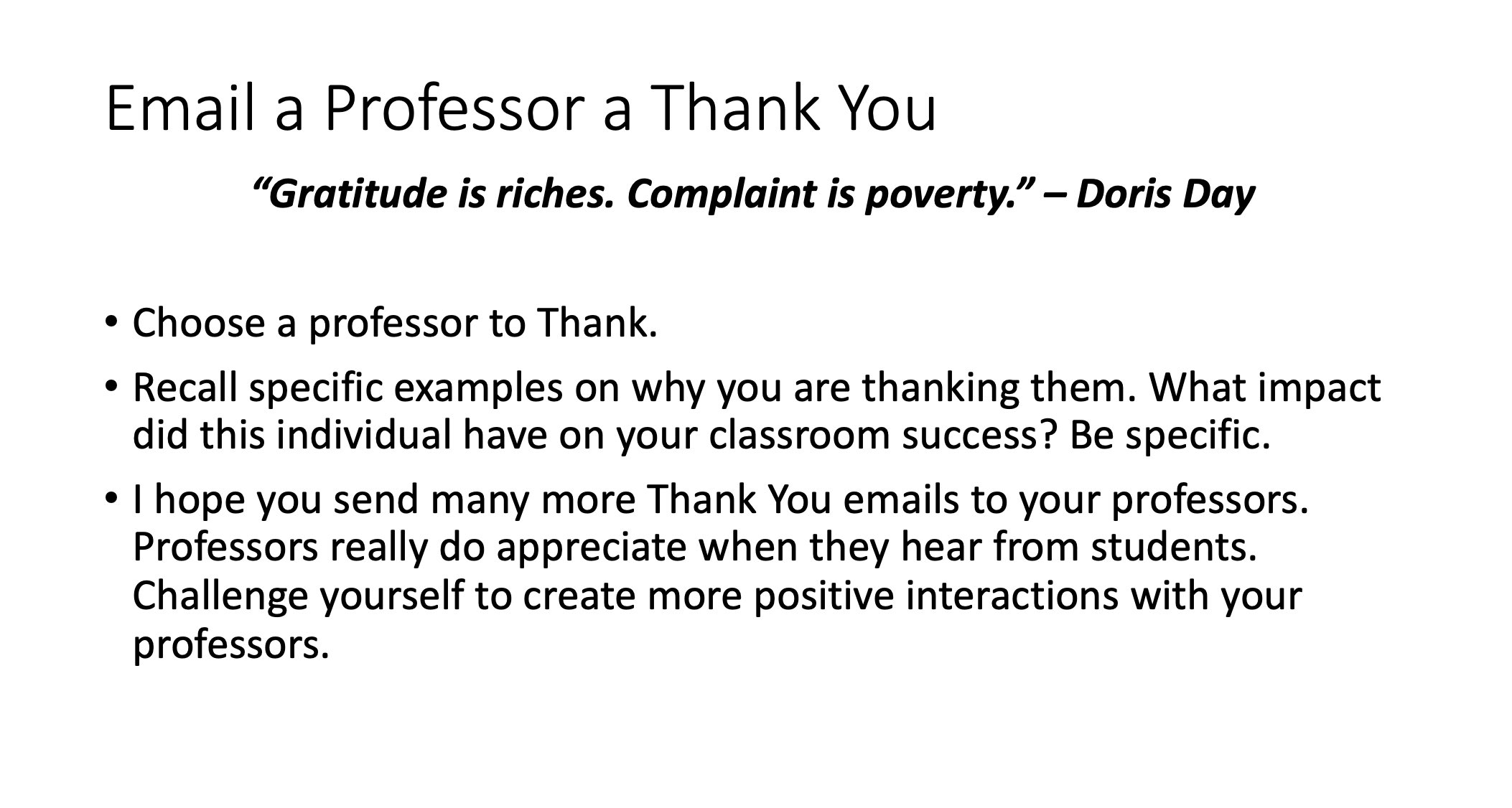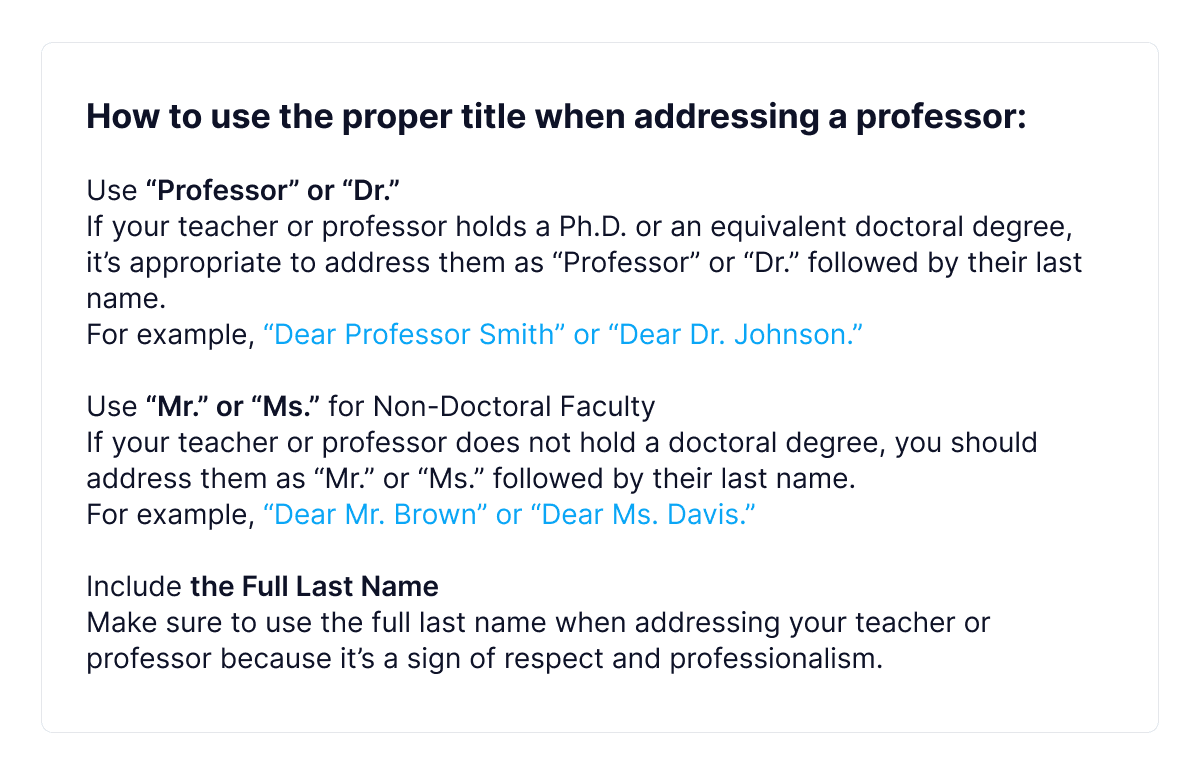Thank a professor in an email by expressing gratitude clearly and sincerely. Use a polite tone and be specific about what you are thankful for.
Writing an email to thank your professor can seem daunting. Yet, it’s a gesture that shows respect and appreciation for their hard work. Professors often go beyond their duties to support and guide students. A well-crafted email can convey your gratitude effectively.
It can strengthen your relationship with your professor. Plus, it can leave a lasting positive impression. Whether it’s for a recommendation, extra help, or just their time, knowing how to properly thank a professor is important. This guide will help you write a sincere thank-you email that your professor will appreciate.
Crafting The Subject Line
Crafting the subject line of your email to thank a professor is crucial. This is the first thing they will see. A clear and concise subject line sets the tone. It ensures your email gets noticed and read. Here are some tips on how to create an effective subject line.
Be Clear And Concise
Keep the subject line short. Avoid long sentences. Use words that are easy to understand. For example, “Thank You for Your Help” is clear. It directly states the purpose of your email. This helps the professor understand what the email is about.
Mention The Purpose
Include the reason for your email in the subject line. This gives context. “Thank You for the Recommendation Letter” is specific. It tells the professor exactly why you are thanking them. This also shows appreciation for their specific action.
By being clear and mentioning the purpose, your email subject line will be effective. Your professor will appreciate your effort to acknowledge their help. A good subject line makes a big difference.
Starting The Email
Starting the email to thank a professor is important. It sets the tone of the message. You want to show respect and gratitude.
Use Formal Greetings
Begin with a formal greeting. Use “Dear” followed by the professor’s title and last name. This shows respect and professionalism.
Address By Title And Name
Always use the professor’s title. This could be “Dr.” or “Professor.” Follow the title with their last name. This demonstrates respect and acknowledges their position.
Expressing Gratitude
Expressing gratitude to a professor through email involves being polite and specific about what you’re thankful for. Begin by addressing them formally and clearly state your appreciation. A concise, sincere message makes a strong impact.
When you want to thank a professor through an email, it’s essential to convey your appreciation genuinely. A well-crafted thank you email not only shows respect but also strengthens your relationship. Let’s dive into how you can express your gratitude effectively.
Be Specific About Help
Being specific about how your professor helped you can make your thank you email more impactful. Instead of a generic “thank you for your help,” mention the exact advice or support you received. Did they provide feedback on a paper? Guide you through a tough concept? Highlighting these details shows that you paid attention and truly valued their assistance.
For instance, you might say, “Thank you for your detailed feedback on my thesis. Your insights on the methodology section were invaluable.” This specificity not only expresses your gratitude but also demonstrates your engagement with their guidance.
Share Impact And Benefits
Discussing the impact and benefits of their help can further convey your appreciation. How did their support make a difference in your academic journey? Did their advice improve your grades or boost your confidence in a subject? Sharing these outcomes makes your gratitude tangible and meaningful.
Consider writing, “Your advice on structuring my arguments significantly improved my final grade. I now feel much more confident in my writing skills.” Sharing these benefits not only thanks your professor but also encourages them to continue supporting students.
By being specific about the help you received and sharing the impact it had on you, your thank you email will be heartfelt and memorable. Why not try these tips the next time you need to thank a professor?

Credit: textcortex.com
Maintaining Professional Tone
Expressing gratitude to a professor via email should be done with a respectful tone. Start with a polite greeting, clearly state your thanks, and close with a courteous sign-off. This approach ensures your message is both professional and sincere.
When you need to thank a professor in an email, maintaining a professional tone is essential. Your email should reflect your respect and appreciation while keeping it formal. This not only ensures clarity but also leaves a positive impression.
Avoid Casual Language
Avoid using casual language like “Hey” or “What’s up”. Instead, start your email with a formal greeting such as “Dear Professor [Last Name]”.
Using phrases like “Thanks a lot” or “You’re awesome” can be too informal. Instead, say “Thank you very much” or “I truly appreciate your assistance”.
Remember, your professor is not your friend; they are your mentor. Address them with the respect they deserve.
Use Proper Grammar
Using proper grammar is crucial. It shows you are serious and respectful.
Take the time to proofread your email. Look out for common mistakes like “your” vs “you’re” and “there” vs “their”.
Using full sentences and proper punctuation helps in making your email clear and professional. For instance, instead of writing “Thanks prof”, write “Thank you, Professor Smith, for your guidance.”
Maintaining a professional tone in your email helps you convey your message respectfully and clearly. It shows that you value your professor’s time and effort. How would you feel if you received a well-crafted, respectful email? Likely, you’d be more inclined to respond positively.
So, take a few extra minutes to ensure your email is professional. Your professor will appreciate it, and it may even benefit you in the long run.
Adding Relevant Details
Express gratitude by mentioning specific help or advice the professor gave. Highlight how it benefited you, showing genuine appreciation.
When thanking a professor in an email, adding relevant details can make your message more meaningful. Specificity shows that you genuinely appreciate their help. It also helps your professor remember you and the context of your gratitude.
Include Course Or Project
Mentioning the course or project can help your professor recall your interactions. For example, you might say, “Thank you for your guidance in the Advanced Biology course.” This simple detail can make your email more personal and specific.
If you worked on a particular project, mention it. “Your advice on my research project about renewable energy was invaluable.” This shows your professor exactly where they made a difference.
Mention Dates Or Events
Referencing specific dates or events can further personalize your message. “I am grateful for your support during the final exams last December.” This detail helps your professor remember the exact time they assisted you.
If a particular event was significant, bring it up. “Your feedback during the midterm presentation in March was incredibly helpful.” This reinforces your gratitude and the context of their help.
Adding relevant details can make your thank-you email stand out. It shows effort and thoughtfulness, making your gratitude more impactful.
Have you ever received a thank-you note that felt truly personal? How did it make you feel? Using these techniques, you can ensure your professor feels the same appreciation.

Credit: x.com
Closing The Email
Express gratitude by sincerely thanking the professor for their time and assistance. Mention specific help or advice received. This shows appreciation and respect.
Closing your email to a professor is just as important as the content within it. It’s the final impression you leave, and it can set the tone for future interactions. This section will guide you through the steps to end your email gracefully and professionally.
Offer Future Contact
Consider expressing your willingness to stay in touch. This shows your professor that you value their guidance beyond this interaction.
For instance, you might say, “I would appreciate any further advice you have” or “I look forward to discussing this more.”
It’s a small gesture that can open the door to future conversations and opportunities. Plus, it shows your ongoing interest in the subject and your proactive attitude.
End With Formal Sign-off
Always end your email with a formal sign-off. This is a simple yet crucial way to show respect and professionalism.
Use phrases like “Best regards,” “Sincerely,” or “Yours faithfully.” This isn’t the time for casual closings like “Cheers” or “Take care.”
Include your full name and contact information below the sign-off. This makes it easier for your professor to remember you and reach out if needed.
Incorporate these tips, and your email will not only thank your professor effectively but also leave a lasting positive impression.
Proofreading The Email
Proofreading your email ensures your gratitude towards a professor is clear and error-free. Double-check spelling, grammar, and tone to convey respect and appreciation effectively.
Proofreading the Email
Writing a thank you email to a professor is important. It shows respect and gratitude. Before hitting send, proofreading your email is crucial. This step ensures your message is clear and error-free. Here are some key aspects to focus on.
Check For Errors
Start by checking for grammatical errors. Even small mistakes can affect the message. Use tools like Grammarly for assistance. Make sure to double-check names and titles. Misspelling a professor’s name can be embarrassing. Punctuation is also important. Correct use of commas, periods, and question marks can improve readability.
Ensure Clarity
Read the email aloud to check for clarity. This helps you hear how your message sounds. Ensure each sentence is clear and to the point. Avoid long, complex sentences and paragraph. Short sentences are easier to read and understand. Make sure your gratitude is clearly expressed. The professor should easily understand your message.
Proofreading your email makes a big difference. It shows you care about your communication. Happy writing!
Sending The Email
Writing a thank you email to a professor shows appreciation for their effort. It helps build a positive relationship. A well-timed, thoughtful email can make a lasting impression.
Timing And Follow-up
Send your email soon after the help or guidance you received. Waiting too long may seem insincere. A prompt email shows you value their time and effort. Follow up if you don’t get a response in a week. Sometimes, emails get lost or overlooked.
Consider The Professor’s Schedule
Professors have busy schedules. They may teach, research, and attend meetings. Send your email during regular working hours. Avoid weekends or holidays, unless it’s urgent. This increases the chance of a quick response.

Credit: www.wikihow.com
Frequently Asked Questions
How Do You Say Thank You Professionally?
Thank you professionally by saying, “I appreciate your assistance,” or “Thank you for your support. ” Another option is “I am grateful for your help. “
How Do I Email A Professor About Being Sick?
Subject: Sick Leave RequestDear Professor [Name],I am unable to attend class due to illness. Please excuse my absence. I will catch up on missed work. Thank you, [Your Name]
How To Show Appreciation To Someone Who Helped You?
Express gratitude with a heartfelt thank you note. Offer a small gift or treat them to coffee. Publicly acknowledge their help.
How To Tell Professor You Won’t Be In Class?
Email your professor politely. State your reason for missing class. Offer to catch up on missed work.
Conclusion
Thanking a professor via email shows respect and gratitude. Keep your message clear and concise. Use a polite tone. Make sure to be specific about what you are thankful for. This thoughtful gesture can leave a positive impression. Professors appreciate knowing their efforts are valued.
So, always take a moment to express your thanks. It can strengthen your academic relationship. Plus, it’s good practice for professional communication. Remember, a little gratitude goes a long way.
